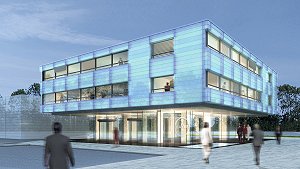BAYER MATERIALSCIENCE
EcoCommercial building making rapid strides / Energy and material saving are twin targets
The EcoCommercial building (ECB) programme launched by Bayer MaterialScience (BMS, Leverkusen / Germany; www.bayerbms.com) three years ago to develop integrated energy and material concepts for industrial and commercial structures has made rapid strides, as CEO Patrick Thomas illustrated at the company’s pre-K 2010 press conference. BMS’ new administrative building being built near New Delhi / India, part of the sustainable construction programme, is now nearing completion. It is claimed to use up to 70% less energy than comparable local buildings.
 A plan of Bayer Material Science's new ecocommercial administrative building in India (Photo: BMS) |
In another project, BMS is cooperating with Masdar, the Abu Dhabi Future Energy Company, on a prototype EcoCommercial building in Masdar City / UAE. This is planned by the government of the emirates state as a hub for global renewable energy and clean technology. The sustainable structures said to be suitable for all climate zones have zero emissions and generate their own electrical power solely from renewable sources such as solar energy. In their construction, BMS’ polycarbonate and polyurethane products are used to make panels for roofs and floors as well as energy-efficient light emitting diodes (LEDs) for indoor and outdoor lighting, PU systems for floor coatings, PC sheet, frames for photovoltaic modules and metal-faced sandwich panels.
Bayer’s polycarbonate sheet is used to make transparent roofing or façade panels of the ECB. These panels have high heat-insulating properties and, as BMS notes, they can be manufactured with less energy than glass. What’s more, they can be mounted with lighter supporting structures, again saving energy in their production.
The company’s energy-saving polymer products also are used in non-construction applications. Bayer’s research is focused on plastic films made with LEDs and organic light emitting diodes (OLEDs). These are said to be suitable for a range of applications, including illuminated packaging, advertising spaces and mobile phone displays. BMS also is developing new holographic photopolymer films designed, among other things, to find use in designer televisions, window display installations, point-of-sale displays and transparent head-up displays for car windshields.
Bayer’s polycarbonate sheet is used to make transparent roofing or façade panels of the ECB. These panels have high heat-insulating properties and, as BMS notes, they can be manufactured with less energy than glass. What’s more, they can be mounted with lighter supporting structures, again saving energy in their production.
The company’s energy-saving polymer products also are used in non-construction applications. Bayer’s research is focused on plastic films made with LEDs and organic light emitting diodes (OLEDs). These are said to be suitable for a range of applications, including illuminated packaging, advertising spaces and mobile phone displays. BMS also is developing new holographic photopolymer films designed, among other things, to find use in designer televisions, window display installations, point-of-sale displays and transparent head-up displays for car windshields.
23.06.2010 Plasteurope.com [216588]
Published on 23.06.2010
